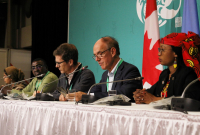Support strong Canadian climate journalism for 2025
Natural Resources Minister Jonathan Wilkinson unveiled Ottawa’s new critical minerals strategy aimed at building supply chains for allies in an era of rising geopolitical tensions with China.
The 58-page strategy launched in Vancouver Friday does not name China directly, but because China is a dominant player in global critical mineral supply chains, the strategy is a clear attempt to eat into Beijing's market share. Canada’s approach follows similar strategies launched by the United States and the European Union earlier this year that explicitly name “breaking dependence” on China as a goal.
“Part of the critical minerals strategy from an international perspective is about geopolitics,” Wilkinson told reporters. “It's about ensuring that not just Canada but democratic countries around the world have access to the resources they require in a manner that does not make them vulnerable in the same way we saw Germany, for example, become vulnerable to pressures from Russia.
“Canada's European allies have recently experienced the consequences of dependence upon non-like-minded countries for strategic commodities like oil and gas. There is a strong desire to avoid recreating these kinds of vulnerabilities in emerging markets such as critical minerals,” he said.
The strategy comes months after Finance Minister Chrystia Freeland’s so-called “Freeland Doctrine” urged western allies to “friendshore” their supply chains. It also comes in the context of other policies aimed to counter China, like the Indo-Pacific Strategy published in late November by Global Affairs Minister Mélanie Joly, which calls China “an increasingly disruptive global power” that “is looking to shape the international order into a more permissive environment for interests and values that increasingly depart from ours.”
The critical mineral strategy is backed by $3.8 billion to support mining companies across various stages of production — from exploring for new mines to manufacturing to recycling.
Wilkinson said the “focus of this strategy will be on expanding this sector” and moving projects forward “expeditiously.”
“With respect to regulatory delays, we must be clear that it cannot take us 12 to 15 years to open a new mine in this country, not if we want to achieve our climate goals and move rapidly through the energy transition, and so we've identified four concrete steps forward,” he said.
The four steps are intended to stickhandle projects faster through the regulatory system. The federal government will create a critical minerals “concierge service” housed within Natural Resources Canada, review federal regulations to speed projects up, work with provinces and territories to align regulations and collaborate with the United States to build a North American market.
“Today’s announcement is a start, but it doesn’t come close to what’s needed for a clean energy industrial strategy, and both workers and the industry are being left behind,” NDP natural resources critic Charlie Angus said in a statement.
“The government’s plans to speed up the approval of projects without rigorous environmental assessments are also deeply concerning, as many of these projects will be proposed on the ecologically fragile lands of the upper boreal forest and the Arctic,” he said. “The government must take the time to include and receive the consent of the Indigenous people who are on the land. Otherwise, many projects will not proceed.”
Critical minerals typically refer to metals and minerals like lithium, nickel, copper and cobalt that are vital to the energy transition off fossil fuels because they’re used for things like electric vehicle batteries, solar panels and wind farms. Many countries have a list of critical minerals, but not each country has the same count. For example, Canada counts commodities it’s a major exporter of like potash, which is used to produce fertilizers, and uranium, used in nuclear power, in its critical mineral strategy.
For Mining Watch Canada’s program co-lead Jamie Kneen, the big problem with the strategy is Ottawa hasn’t recognized that meaningfully addressing the climate crisis requires changing how our economies work, not just swapping in cleaner alternatives.
Rather than making major investments in public transportation, the current focus is on shifting to electric vehicles. Instead of shifting agriculture production to be more sustainable, “they’re talking about making sure we’ve got lots of potash production,” he said.
“That’s the kind of more systemic approach that’s just completely absent” in the strategy, he added.
“It’s really missing what you might call a whole-of-government approach because it's not looking at rural development, it's not looking at urban development, it's just looking at manufacturing and production.”
The plan is not comprehensive enough for Kneen, who says it falls short compared to investments seen by allies like the United States. Canada’s plan “suffers in comparison” to the U.S.’s Inflation Reduction Act, which goes much further than Ottawa, or any of the provinces, have yet gone in terms of actual investments, Kneen said.
“The Americans are already putting money into Canadian junior mining companies where they see projects that they think are promising and products that they’re interested in — they want to make sure that something's going to go ahead,” he said. “Canada's still just looking at market mechanisms, and subsidies, and free infrastructure — basically, we'll build roads and power supplies for these projects but we're not actually buying into them.
“It's a really neoliberal approach. It's very much hands-off,” he said. It’s as if the “government's role is to throw money at things and not to expect results.”






Comments
While I agree that we need to become less dependent on countries like China for critical minerals (and start manufacturing more products in North America so we don't have to buy stuff made in China), I also agree with Mining Watch's Jamie Kneen that we have to be careful. Mining can be so destructive to the land and water, causing more negative impacts to biodiversity (is Wilkinson listening to the reports from COP 15?). And, of course, all these projects will be on Indigenous territories. Will Indigenous people's rights to Free Prior Informed Consent be honoured? Regarding "fast -tracking" mining applications, it may sound good, but we already have watered -down Environmental Assessment legislation federally, and in most cases, provincially.
How easily we forget the extreme damage that mining causes to wildlife, to wilderness, to biodiversity, to rivers, to lakes, to communities. How easily we buy the notion that there are industrial solutions to the harm that industry has caused. How easily we think that everyone buying a new electric vehicle will save the world, without thinking of the harm generating electricity can do - green fields turned into industrial wind or solar "farms", hydroelectric dams we pretend are green.
How the mining industry must rub its collective hands in glee that it has gone from one of the most destructive industries on the planet to ecological savior. Perhaps we should all think just a little harder, a little broader, and consider the consequences.
As for Canada's Liberal government, it is the absolute pinnacle in pretending to be green while paving the way for more subsidized fossil fuels, supporting more coal, exporting fossil fuels while not counting the emissions of combustion wherever it may occur, developing wildly destructive ports like Roberts Bank Terminal 2, promoting staggeringly destructive mining. The list goes on. Yet we go along, we fall for it, as Mr. Woodside has done.